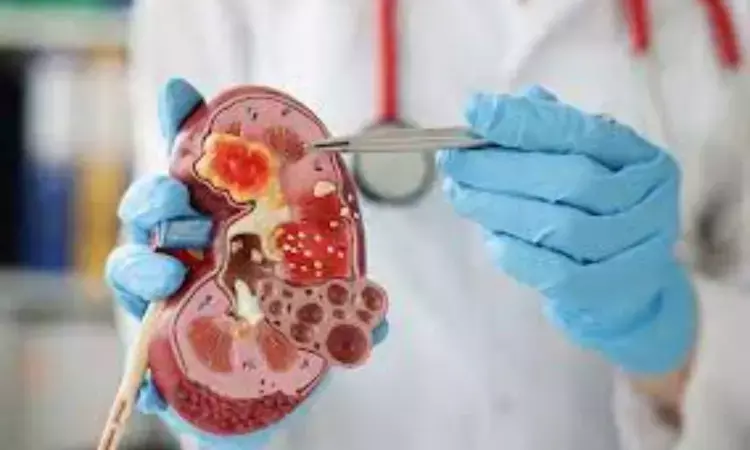- Home
- Medical news & Guidelines
- Anesthesiology
- Cardiology and CTVS
- Critical Care
- Dentistry
- Dermatology
- Diabetes and Endocrinology
- ENT
- Gastroenterology
- Medicine
- Nephrology
- Neurology
- Obstretics-Gynaecology
- Oncology
- Ophthalmology
- Orthopaedics
- Pediatrics-Neonatology
- Psychiatry
- Pulmonology
- Radiology
- Surgery
- Urology
- Laboratory Medicine
- Diet
- Nursing
- Paramedical
- Physiotherapy
- Health news
- Fact Check
- Bone Health Fact Check
- Brain Health Fact Check
- Cancer Related Fact Check
- Child Care Fact Check
- Dental and oral health fact check
- Diabetes and metabolic health fact check
- Diet and Nutrition Fact Check
- Eye and ENT Care Fact Check
- Fitness fact check
- Gut health fact check
- Heart health fact check
- Kidney health fact check
- Medical education fact check
- Men's health fact check
- Respiratory fact check
- Skin and hair care fact check
- Vaccine and Immunization fact check
- Women's health fact check
- AYUSH
- State News
- Andaman and Nicobar Islands
- Andhra Pradesh
- Arunachal Pradesh
- Assam
- Bihar
- Chandigarh
- Chattisgarh
- Dadra and Nagar Haveli
- Daman and Diu
- Delhi
- Goa
- Gujarat
- Haryana
- Himachal Pradesh
- Jammu & Kashmir
- Jharkhand
- Karnataka
- Kerala
- Ladakh
- Lakshadweep
- Madhya Pradesh
- Maharashtra
- Manipur
- Meghalaya
- Mizoram
- Nagaland
- Odisha
- Puducherry
- Punjab
- Rajasthan
- Sikkim
- Tamil Nadu
- Telangana
- Tripura
- Uttar Pradesh
- Uttrakhand
- West Bengal
- Medical Education
- Industry
Ureteroscopy and Shockwave Lithotripsy exhibit Similar kidney stone Clearance: JAMA

A new study published in the Journal of American Medical Association found that despite shockwave lithotripsy and ureteroscopy having comparable kidney stone clearance rates, patients felt that shockwave lithotripsy was a superior overall experience.
Despite the ambiguity and equal weight of guidelines for shockwave lithotripsy and ureteroscopy, ureteroscopy is the most common treatment for kidney and ureteral stones in children and adolescents. Thus, to assess stone clearance and patient-reported outcomes following ureteroscopy or shockwave lithotripsy, this study was carried out in children and adolescents.
The patients were recruited for this nonrandomized clinical research at 31 US and Canadian medical facilities between March 16, 2020, and July 31, 2023. The patients with ureteral stones, kidney stones, or both who were between the ages of 8 and 21 were included. The last day of follow-up was October 15, 2023.
6 (±2) weeks following surgery, the main result was the stone removal measured by standardized ultrasonography. Stone clearance was assessed per kidney or ureter using logistic regression, and estimated stone clearance rates were produced for each operation using inverse probability weighting and random intercepts each location.
A total of 1,142 patients (690 females [60.4%]) with a median age of 15.6 years (IQR, 12.6-17.3 years) were included in this research. Regarding race and ethnicity, 884 patients (77.4%) were White, 130 patients (11.4%) were Hispanic, and 41 patients (3.6%) were Black.
A median stone size of 6.0 mm (IQR, 4.0-9.0 mm) was found in 1069 kidneys or ureters treated by 124 urologists using ureteroscopy and shockwave lithotripsy (n = 953 and 189 patients), respectively.
Almost, 841 operations for 767 patients (80.4%) undergoing ureteroscopy and 6 procedures for 5 patients (2.6%) undergoing shockwave lithotripsy involved the placement of ureteral stents at the time of index surgery.
In 105 patients who had shockwave lithotripsy (67.5% [95% CI, 61.0%-74.1%]) and 474 patients who had ureteroscopy (71.2% [95% CI, 63.8%-78.5%]), stone removal was achieved; however, this difference was not statistically significant (risk difference, 3.6% [95% CI, −6.2% to 13.5%]).
One week following surgery, ureteroscopy caused more urinary symptoms (symptom score difference, 3.9 [95% CI, 1.2-6.7]) and discomfort interference (T-score difference, 5.0 [95% CI, 2.3-7.8]) than shockwave lithotripsy.
In the week after surgery, ureteroscopy patients missed more coursework (risk difference: 21.3% [95% CI: 9.7%-32.8%]) and caregivers missed more work (risk difference: 23.0% [95% CI: 11.0%-35.0%]). Overall, improved patient-reported outcomes were linked to shockwave lithotripsy.
Reference:
Tasian, G. E., Chu, D. I., Nelson, C. P., DeFoor, W. R., Ziemba, J. B., Huang, J., Luan, X., Kurtz, M., Ching, C. B., Dangle, P., Schaeffer, A. J., Sturm, R., Wu, W., Bayne, C., Fernandez, N., Chua, M. E., DeMarco, R., Ellsworth, P., Augelli, B., … Meenakshi-Sundaram, B. (2025). Ureteroscopy vs shockwave lithotripsy to remove kidney stones in children and adolescents: A nonrandomized clinical trial: A nonrandomized clinical trial. JAMA Network Open, 8(8). https://doi.org/10.1001/jamanetworkopen.2025.25789
Neuroscience Masters graduate
Jacinthlyn Sylvia, a Neuroscience Master's graduate from Chennai has worked extensively in deciphering the neurobiology of cognition and motor control in aging. She also has spread-out exposure to Neurosurgery from her Bachelor’s. She is currently involved in active Neuro-Oncology research. She is an upcoming neuroscientist with a fiery passion for writing. Her news cover at Medical Dialogues feature recent discoveries and updates from the healthcare and biomedical research fields. She can be reached at editorial@medicaldialogues.in
Dr Kamal Kant Kohli-MBBS, DTCD- a chest specialist with more than 30 years of practice and a flair for writing clinical articles, Dr Kamal Kant Kohli joined Medical Dialogues as a Chief Editor of Medical News. Besides writing articles, as an editor, he proofreads and verifies all the medical content published on Medical Dialogues including those coming from journals, studies,medical conferences,guidelines etc. Email: drkohli@medicaldialogues.in. Contact no. 011-43720751


